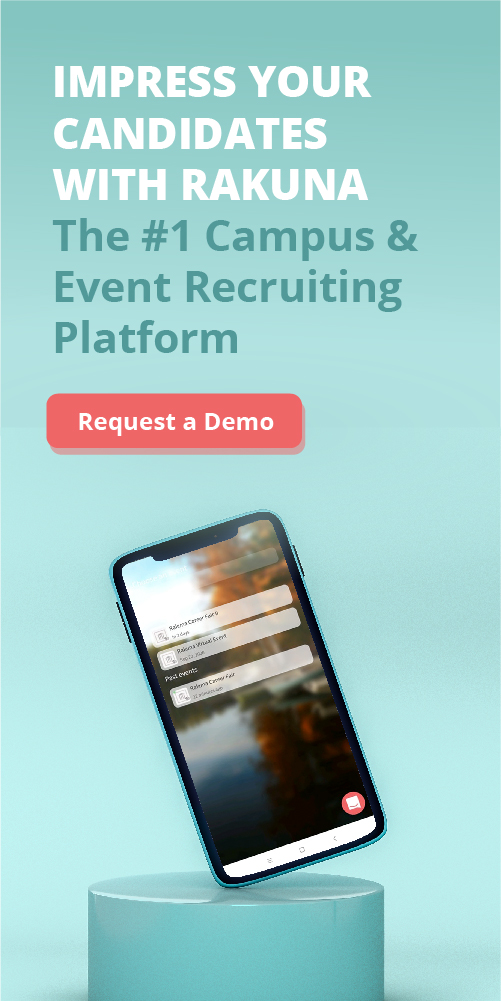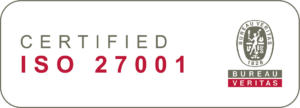Attracting qualified student talent through campus and event recruiting has become increasingly complex in today’s fast, evolving landscape. As recruitment methods shift, so do candidate expectations, and staying ahead requires strategy, data, and adaptability.
Recent findings from Daniel Goller and his team (2025) reveal that virtual career fairs generate 17% more candidate interest compared to traditional in-person events, which show only a 4% increase. This suggests that digital engagement is becoming a stronger driver of early talent attraction.
Meanwhile, the 2024 Employ Recruiter Nation Report highlights a significant rise in technology adoption: 63% of 1200 surveyed recruiters are now leveraging AI to streamline hiring processes and enhance candidate experiences.
As competition for top talent intensifies, refining your campus recruiting strategy is no longer optional—it’s essential. This guide offers practical, research-backed insights to help your team adapt, attract the right candidates, and strengthen your overall campus recruitment efforts.
CAMPUS RECRUITING STRATEGY: PREPARATION PHASE
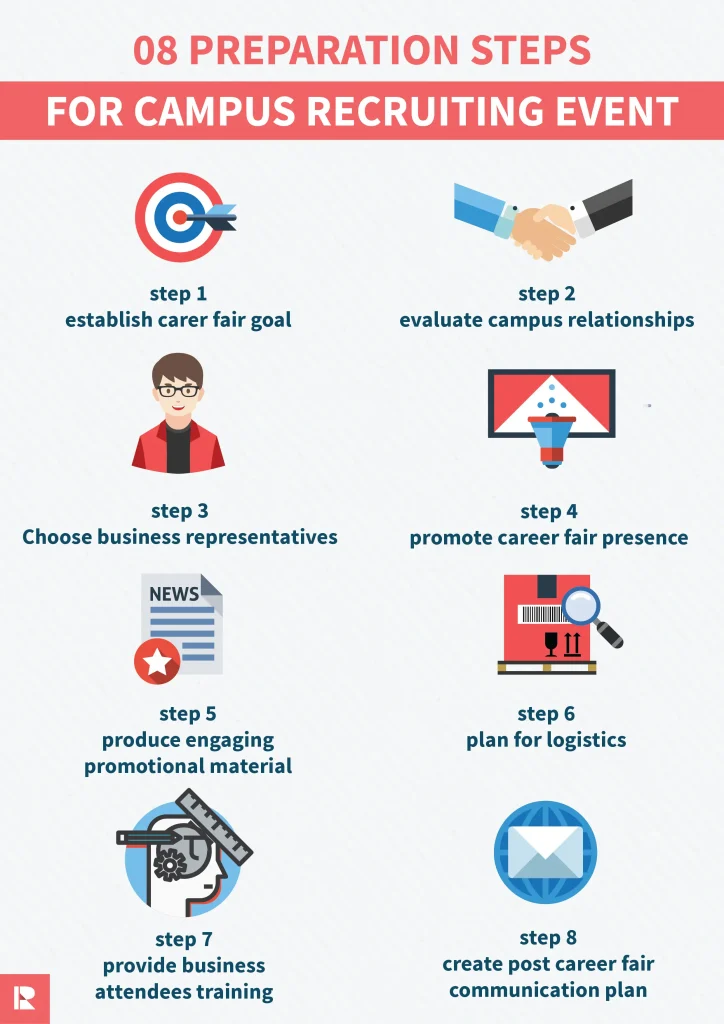
✅ ESTABLISH CAREER FAIR GOALS
Effective campus recruiting begins with intentional planning. Research led by Dr. Susan Gordon (2014), examining the role of career fairs in the hospitality and tourism sectors, found that employers gain the most value from these events when guided by well-defined objectives – whether it’s enhancing employer brand visibility, building industry connections, or sourcing talent for specific roles.
To ensure your participation translates into meaningful outcomes, begin by aligning your team around the “why” behind attending. Is your focus on filling high-priority roles, raising awareness among early talent, or cultivating a longer-term talent pipeline?
Key Questions to Guide Goal-Setting:
- What specific roles, skill sets, or departments are we prioritizing at this fair?
-
What metrics will define success (e.g., number of quality conversations, interviews booked, offers extended)?
-
Are our goals aligned with both current hiring needs and future workforce planning?
-
What level of employer brand recognition are we aiming to establish or reinforce?
-
Are all team members aligned on how to communicate our value proposition clearly to candidates?
Gordon’s research also underscores the importance of cross-department collaboration. When recruiters consult with department leads before attending a fair, they gain a deeper understanding of urgent hiring needs, anticipated openings, and skill gaps—ensuring that recruitment efforts are strategic rather than generic.
Further Considerations:
-
Have we gathered input from all departments with current or upcoming talent needs?
-
Are we targeting emerging roles or skills reflective of industry trends?
-
If candidate interest exceeds expectations, how will we prioritize high-potential leads?
-
Do we have a clear process for capturing and sharing candidate data post-event?
✅ EVALUATE CAMPUS RELATIONSHIPS
Building effective relationships with campus organizations and career centers requires more than just good intentions—it requires strategy. With limited time and resources, recruiting teams must assess the return on investment (ROI) of each partnership to ensure efforts align with broader talent acquisition goals.
💡 Rather than defaulting to schools with strong reputations or past affiliations, top-performing recruiters emphasize a data-driven selection process. This includes evaluating program alignment with your organization’s hiring needs, analyzing student demographics, and monitoring institutional trends such as program growth and graduation rates.
💡 Establishing early contact with career centers at high-potential schools helps streamline event logistics, boost campus visibility, and open the door to deeper engagement opportunities like info sessions, workshops, or student org partnerships.
Key Questions to Guide Campus Selection:
-
Does this school offer a strong pipeline of students in relevant academic programs?
-
What is the diversity makeup of the student body, and how does it support our DEI goals?
-
Do the program curricula and internship opportunities align with the skills we prioritize?
-
Are enrollment trends in these programs increasing, stable, or declining?
-
Are our school selection criteria clearly tied to business objectives, not personal bias or legacy preferences?
✅ CHOOSE BUSINESS REPRESENTATIVES WISELY
The individuals you send to represent your organization at campus events do more than just hand out business cards – they shape candidate perceptions, reinforce your employer brand, and influence the likelihood of post-event engagement. Selecting and preparing these representatives with intention is one of the most critical – and most overlooked – steps in building a high-impact campus recruiting strategy.
Recruiting leaders from high-performing organizations report that bringing a strategic mix of senior leaders, recent grads, functional specialists, and alumni enhances student engagement by appealing to a variety of interests and career stages.
💡 Senior leaders bring credibility and vision, while newer hires and alumni provide authenticity and relatability. Each rep is assigned a clear role, and organizations often provide pre-event training to ensure consistency in messaging, especially around growth paths, company culture, and role expectations.
Strategic Questions to Ask:
-
Do our representatives reflect the diversity, roles, and career paths we aim to showcase?
-
Have we defined each representative’s role and expectations clearly (e.g., brand ambassador, subject matter expert)?
-
Are our reps prepared to answer both high-level and technical questions with clarity?
-
How will we ensure all representatives are approachable, enthusiastic, and aligned with our employer branding?
-
Are we actively leveraging alumni or employees who can speak authentically to the student experience?
✅ PROMOTE YOUR CAREER FAIR PRESENCE
Even the most eye-catching booth or sharpest team won’t help if students don’t know you’re attending. Strategic pre-event promotion is a cornerstone of successful campus recruiting—and it’s one area where tech-savvy recruiters can gain a serious competitive edge.
Today’s top recruiters go beyond email blasts and flyers. They leverage dedicated career fair landing pages, targeted social media campaigns, and integrations with campus recruiting platforms to maximize visibility and drive pre-registration. The result? A more qualified, informed, and engaged candidate pipeline before the booth even opens.
💡 Based on Rakuna’s experience when supporting our enterprise clients, we recommend launching career fair promotions at least 2–3 weeks in advance across channels students already use—think LinkedIn, Instagram, Handshake, and campus newsletters. Create a mobile-friendly landing page where students can pre-register, upload their resumes, and get answers to FAQs. Consider adding a countdown timer, teaser videos, or student testimonials from past events to drive engagement.
Strategic Questions to Ask:
- Do we have a clear, mobile-optimized landing page dedicated to this career fair?
- Is the registration experience fast, intuitive, and friction-free for students?
- Are we offering prep materials or FAQs to boost candidate confidence ahead of time?
- How are we using sign-up data to personalize follow-ups and booth interactions?
- Are we sending helpful reminders or countdowns to registrants pre-event?
- Have we secured placement on official university and event websites?
- Are we promoting any giveaways, info sessions, or exec meet-and-greets to stand out?
- Did we launch our promotion early enough to build meaningful awareness?
- Are we tracking student interactions or questions before the event?
- Is the “share” function turned on—and clearly visible—on all digital materials?
- Are we using consistent branding, tone, and hashtags across all platforms?
- Have we activated student ambassadors or employees to promote the event within their networks?
- What metrics (e.g., landing page visits, shares, registration rates) are we using to assess promotional success and inform future campaigns?
✅ PRODUCE ENGAGING PROMOTIONAL MATERIALS
Craft promotional materials that don’t just inform, they resonate and highlight young talent’s concerns and needs. According to the National Association of Colleges and Employers (NACE) 2024 Student Survey, graduating seniors prioritize economic security, defined as job stability, annual salary increases, and comprehensive benefits packages, when evaluating potential employers.
To stand out, tailor your materials to highlight aspects of your organization that align with these priorities. Collaborate with your marketing team to develop both physical and digital assets that showcase unique insights into your company’s culture, growth opportunities, and employee experiences. Digital materials not only reduce paper usage but also appeal to environmentally conscious students, reflecting your company’s commitment to sustainability.
Must-Haves for Modern Campus Recruiting Materials
-
Role-Specific Journeys: Illustrate clear career progression paths within your organization.
-
Impact Metrics: Highlight team achievements with quantifiable results.
-
Exclusive Insights: Share day-in-the-life stories or behind-the-scenes looks at your teams.
-
Values in Action: Demonstrate how your company lives its mission and values.
-
Sustainability Angle: Emphasize your commitment to environmental responsibility through digital materials and green initiatives.
✅ Nail Your Campus Career Fairs Logistics
Campus career fairs are a whirlwind – a fantastic opportunity to connect with bright minds, but also a potential logistical headache. Getting your booth, materials, and team to the right place at the right time sounds simple, but seasoned recruiters know it’s where things can often go sideways. Don’t let logistical hiccups derail your efforts.
- Map Your Mission: Start with a shared recruitment schedule. Who needs to be where, when? What are the key deadlines for shipping materials, booth setup, and travel? Clarity prevents confusion.
- Track Everything: Lost brochures or a missing tablecloth can tarnish your brand image. Monitor event shipments like a hawk. Consider using campus recruitment software or project management tools with tracking features – they can be lifesavers for managing multiple events.
- Communicate Clearly: Ensure everyone on your team (recruiters, business attendees, support staff) has the detailed timeline and understands their role. Regular check-ins prevent last-minute scrambles.
Pre-Fair Logistics Checklist
Feel free to customize this template to fit your event & campus recruiting operation:
[ ] Event registration confirmed & paid?
[ ] Booth location finalized?
[ ] Team travel & accommodation booked?
[ ] Marketing collateral (brochures, swag) ordered & shipped?
[ ] Shipment tracking numbers monitored?
[ ] Tech (laptops, tablets, chargers, QR codes) prepped & tested?
[ ] Clear schedule & roles communicated to all attendees?
[ ] Lead capture method defined (app, forms, QR code)?
✅ Train Your Ambassadors
The first day of a career fair is electric, but it can quickly become overwhelming. Your booth staff – often including enthusiastic but less experienced business attendees – are the face of your company. Training isn’t just nice-to-have; it’s essential for making meaningful connections.
- Align on Goals: Before the event, dedicate real time (don’t just squeeze it in!) to clearly communicate: What does success look like for this fair? Are you focusing on specific roles, building a general talent pipeline, or boosting brand awareness? Define the key metrics you’ll track.
- Tech & Talk Tracks: Familiarize your team with any recruiting apps or lead capture technology you’re using. Nothing stalls a conversation faster than fumbling with a tablet. Practice! Consider quick mock sessions focusing on:
- ✔ Your company’s elevator pitch.
- ✔ Key roles you’re hiring for.
- ✔ Answering common student questions authentically.
- ✔ How to gently guide conversations and capture information efficiently.
Did You Know? Research consistently shows that students value authentic interactions. According to Ethan McCarty, one of Forbes’ Council Members, Gen Z candidates prioritize understanding company culture and seeing genuine enthusiasm from representatives. Untrained or unprepared staff can inadvertently send the wrong message.
✅ CONSIDER POST-CAREER FAIR COMMUNICATION PLANS
The career fair doesn’t end when the booths come down. In fact, what happens next is often what separates top recruiting teams from the rest. Hundreds of talented students engaged with your brand – don’t let that momentum fade!
- Plan Before You Go: Don’t wait until you’re back in the office, buried under resumes. Craft your post-event communication plan in advance. What’s the timeline? Who sends what? What are the key messages?
- Personalization Matters (A Lot): Generic blasts get ignored. Simple gestures resonate. Aim to:
- ✔ Send personalized emails (or connection requests on relevant platforms like LinkedIn) within 24-48 hours. Reference something specific from your conversation if possible.
- ✔ Thank candidates for their time and interest.
- ✔ Clearly outline the next steps and encourage applications or interviews for relevant roles.
Research Insight: Timeliness is critical. While specific stats vary year-to-year, student surveys (like those conducted by NACE or universities) frequently indicate that a significant majority of students expect prompt follow-up after meeting a recruiter, often within a week at most. Waiting longer risks losing engaged candidates to faster-moving competitors.
Manually tracking hundreds of conversations is tough. Campus recruiting software with an event repository, like Rakuna’s, is invaluable here. It helps organize candidate info, automate initial follow-ups (use templates wisely!), and track engagement.
💡 Best Practice – Nurture Future Talent: Met a promising student who isn’t quite ready for a current role (e.g., a sophomore)? Don’t discard their information! Add them to your talent hub or recruiting CRM.
Send occasional, relevant updates (company news, future internship announcements). Keeping them warm builds your long-term pipeline, so when they are ready, your company is top-of-mind.
2. MARKETING AND COMMUNICATIONS FOR YOUR CAMPUS RECRUITING STRATEGY
In a hyper-connected world, reaching potential college hires means meeting them where they naturally spend their time. And overwhelmingly, that’s online and on social media. But simply being there isn’t enough; you need a strategy built on understanding and genuine connection.
Mastering Social Media Engagement
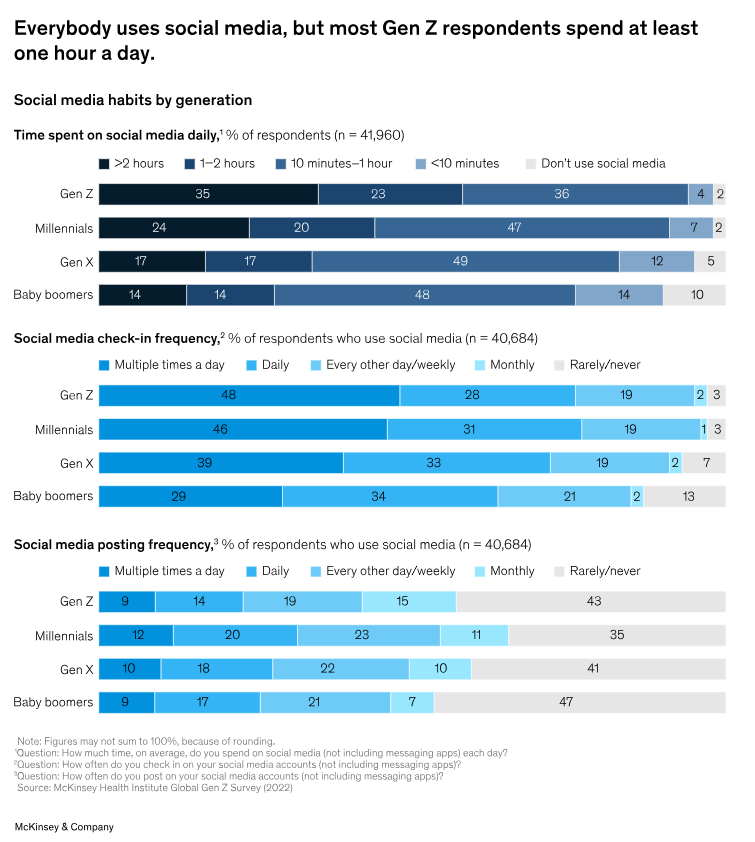
Gone are the days when social media was just an afterthought for recruitment. For Generation Z, it’s a primary source of information, connection, and brand discovery.
According to McKinsey, out of 42,000 survey respondents across 26 countries, over one-third of Gen Z respondents say they spend more than two hours each day on social media sites
Platforms like TikTok, Instagram, and YouTube are central to their digital lives, with LinkedIn gaining traction for career exploration, especially among older students and recent graduates.
- Strategic Presence: Don’t just broadcast – engage. Understand the nuances of each platform. What works on LinkedIn (professional insights, job postings) differs wildly from TikTok or Instagram (behind-the-scenes, authentic culture snippets, short-form video).
- Listen & Learn: Pay attention to conversations happening in student communities online. What are their concerns? What questions are they asking about careers in your industry? Use social listening to inform your content and engagement strategy.
- Show, Don’t Just Tell: Use social media to offer a genuine glimpse into your company life. Feature employee takeovers, ‘day in the life’ videos, Q&A sessions with recent hires or team leaders. Authenticity resonates far more than polished corporate jargon.
Best Practice: Encourage your current interns or recent graduate hires to share their real experiences (within guidelines, of course). Peer-to-peer insights are incredibly powerful and trusted. Frame your company not just as a workplace, but as a launchpad for learning and growth.
Platforms for Gen Z Campus Recruiting
- Instagram/TikTok: Best for visual storytelling, showcasing culture, ‘day-in-the-life’ content, short video, employer branding. High engagement potential.
- YouTube: Ideal for slightly longer-form content – detailed company overviews, employee interviews, virtual tours, explainer videos about roles/projects.
- LinkedIn: Crucial for professional networking, targeted job postings, sharing industry insights, highlighting employee achievements, and career paths. Especially relevant for juniors, seniors, and recent grads.
- Niche Platforms (Discord, Reddit): Can be valuable for specific tech or interest-based communities, but require careful, authentic engagement.
💡 Check out this extended list of niche social media platforms to find qualified young talent
Create Content That Clicks: Career Orientation & Value Proposition
Beyond general engagement, your content needs to actively help students envision their future with your company. Think less about hard selling and more about providing genuine value and orientation.
- Map the Journey: Craft content that clearly outlines potential career paths. What does growth look like in the first 1-3 years? What skills will they learn? Showcase diverse roles and trajectories within the company.
- Speak Their Language: Young professionals today often prioritize meaningful work, continuous learning, clear development opportunities, and a healthy work-life balance. Your messaging should reflect an understanding of these desires. Address topics like mentorship programs, training opportunities, company values in action (DEI, sustainability), and flexibility where applicable.
- Be Useful: Think about the practical questions students have: How to ace an interview? What skills are most in-demand? Resume tips? Creating helpful, non-promotional content positions you as a valuable resource, building trust long before they even apply.
Consider This: Every post, video, or interaction shapes your employer brand. What core message do you want students to associate with your company? Ensure your online presence consistently reflects your company’s culture and values.
Check out how PwC Singapore is applying this campus recruiting strategy:
MAKE YOUR CONTENT MOBILE-FRIENDLY
You’ve crafted great content and identified key platforms – now ensure students can actually find you easily and stay connected. This involves optimizing for how they search and building genuine, long-term relationships.
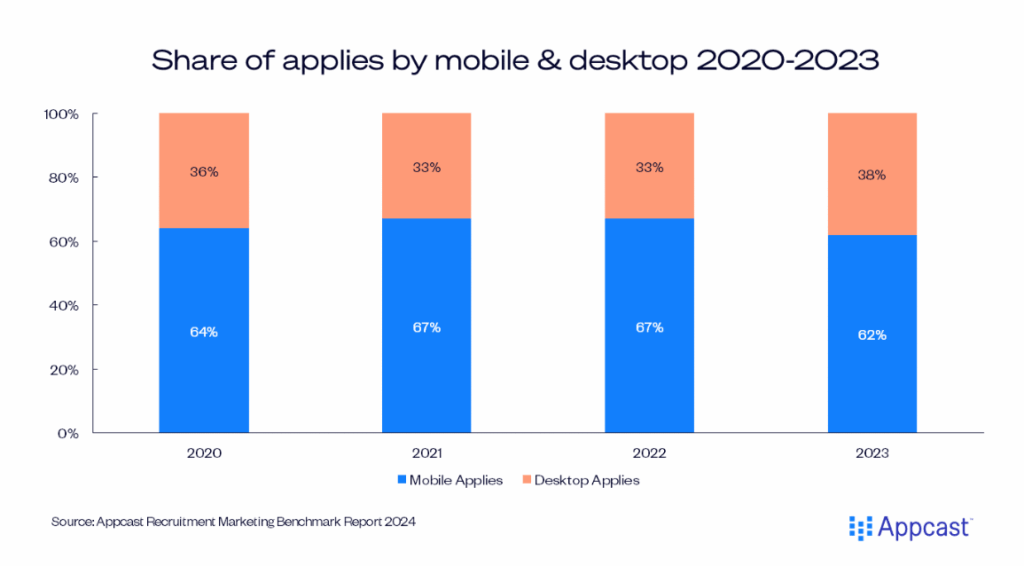
Mobile is Non-Negotiable. It’s no longer just a trend; it’s the standard. Recent data from Appcast consistently shows a massive share, often well over 60-70%, of job searches, especially initial discovery, happening on mobile devices. A clunky, slow, or hard-to-navigate mobile experience is a major deterrent, causing high application drop-off rates.
True Mobile-Friendliness Means:
- Responsive Design: Your careers page and content must automatically adapt to any screen size.
- Fast Loading Speed: Optimize images and code. Test using tools like Google’s PageSpeed Insights.
- Easy Navigation: Simple menus, clear calls-to-action, and minimal clicks to find key info (open roles, program details).
- Simplified Applications: Can candidates easily apply or express interest via mobile without needing complex file uploads or desktop-only features?
Mobile Experience Quick Check 💡
- Can a candidate easily browse open roles on their phone?
- Does your career site load in under 3 seconds on a mobile connection?
- Is the application process straightforward on mobile (or offer an ’email me this job’ option)?
- Are text and buttons easily readable and clickable without zooming?
Get Found: A Practical SEO Guide for Attracting Student Talent

Organic search is still one of the most powerful (and budget-friendly) ways to get your opportunities in front of students. But here’s the catch: if your jobs aren’t discoverable using the words students actually search for, you’re invisible. So how do you make sure your roles rise to the top? Let’s break it down.
1. Get Inside a Student’s Head
First rule of SEO: it’s not about what you call your roles—it’s about what students think to type. This means ditching generic phrases like “exciting opportunities” and instead zoning in on specifics. Ask yourself: If I were a student job-hunting at midnight, what would I search?
Role-Specific Terms: Be crystal clear. Instead of “Junior Developer,” students might search “entry-level software engineer jobs” or “new grad UX designer positions.” Always spell it out.
Location-Specific Phrases: Students often want to work close to home (or a specific city they dream about). Incorporate searches like “graduate finance roles Ho Chi Minh City” or “internships Chicago summer 2026.” Tailor the location based on where your roles are.
Program-Specific Keywords: Not every student is hunting for a one-off job. Many are drawn to structured pathways. Use terms like “university graduate rotation program,” “co-op opportunities in engineering,” or “summer analyst program.”
Culture & Values: Today’s students care a lot about what your company stands for. They’ll search phrases like “tech jobs focus on sustainability,” “diverse and inclusive workplace entry-level,” or “remote-first graduate roles.” Weave in what makes your culture stand out—this helps both SEO and builds trust.
2. Optimize Your Career Site—Properly
This isn’t about stuffing keywords in like you’re cramming for finals. Make sure your site naturally integrates these search-friendly phrases across:
Job Descriptions: Ditch buzzwords; use clear titles and phrases that match real-world search terms.
Program Pages: Whether it’s your internship, graduate program, or rotational scheme, describe it with the terms students are actually looking up.
Blog Content: Have a student success story or “day in the life” feature? Great spot to include location- and program-specific terms (in a way that feels human, not robotic).
SEO might seem like a back-end task, but it’s really just about speaking your candidates’ language. The more you align your content with what students are already searching for, the easier it is for them to find you
3. Applying Technology to Your University & College Recruitment Strategies
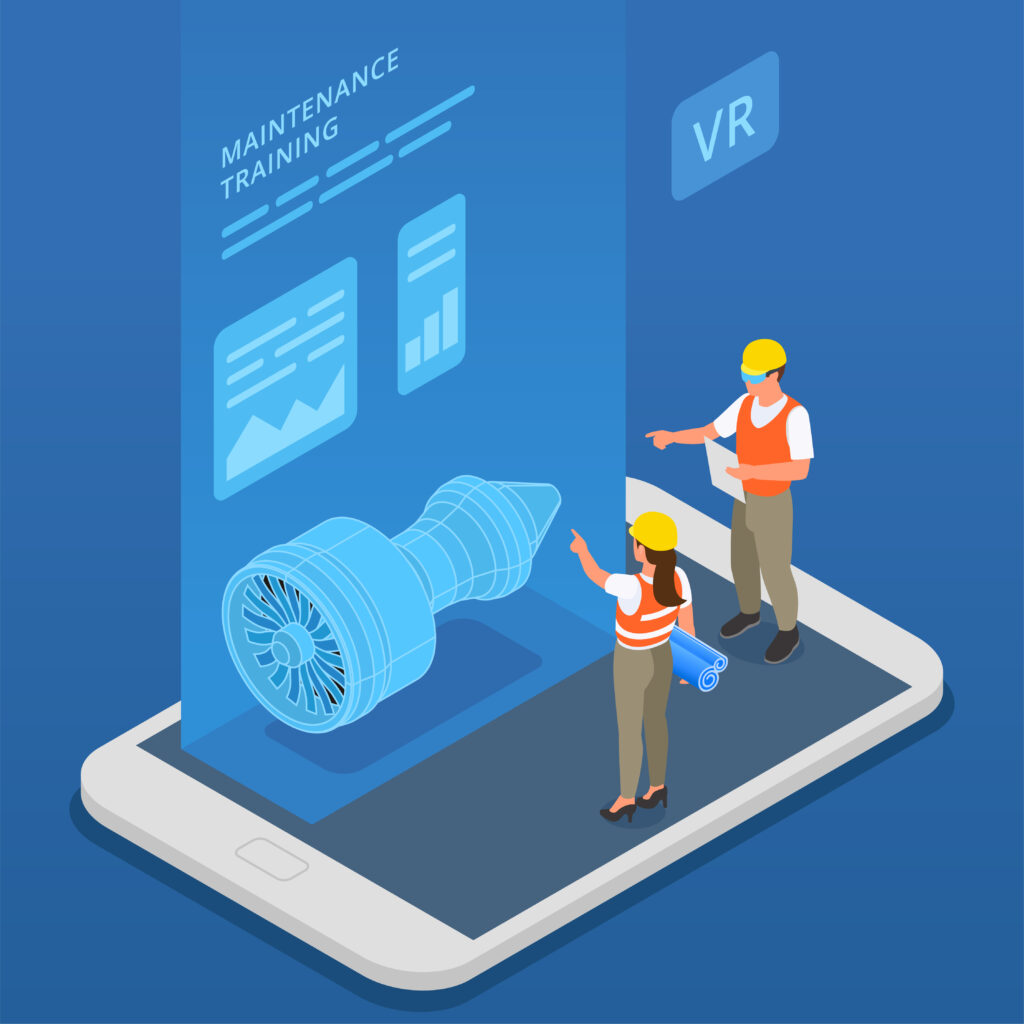
As a campus recruiter, you must keep yourself up-to-date with the ever-changing landscape, and yes, things are very much changing now. With the tech-savvy Gen Z and Gen Alpha reshaping the global job markets along with technologies like Large Language Model AI, both your campus recruiting strategy and your technical toolbox need sharpening.
Find Talent on Online Platforms & ePortfolios
Beyond traditional job boards, there are platforms that allow students to showcase a richer picture of their abilities are gaining traction.
Consider platforms where students can display academic work, projects, and skills visually. Tools like Portfolium (now part of Instructure) are examples of ePortfolio networks that aim to give employers a more holistic view of a student’s capabilities beyond a static resume.
The goal with such platforms is to improve candidate quality and potentially reduce hiring time by offering a richer initial assessment. Look for platforms that integrate well with your existing systems and are actively used by students in your target disciplines.
💡 When assessing online sourcing tools or ePortfolio networks, ask:
- Student Adoption: Is this platform widely used and valued by students in our target majors/universities?
- Skill Showcase: Does it allow students to demonstrate practical skills, projects, and not just list experiences?
- Integration: Can it easily feed candidate data into our ATS or CRM?
- Ease of Use: Is it intuitive for both recruiters and students?
- Analytics: Does it offer insights into candidate engagement or skill matches?
📝 To help you kickstart your talent search, try these region-specific university and college recruiting websites & platforms
Optimizing Career Fair Engagement (In-Person & Virtual)
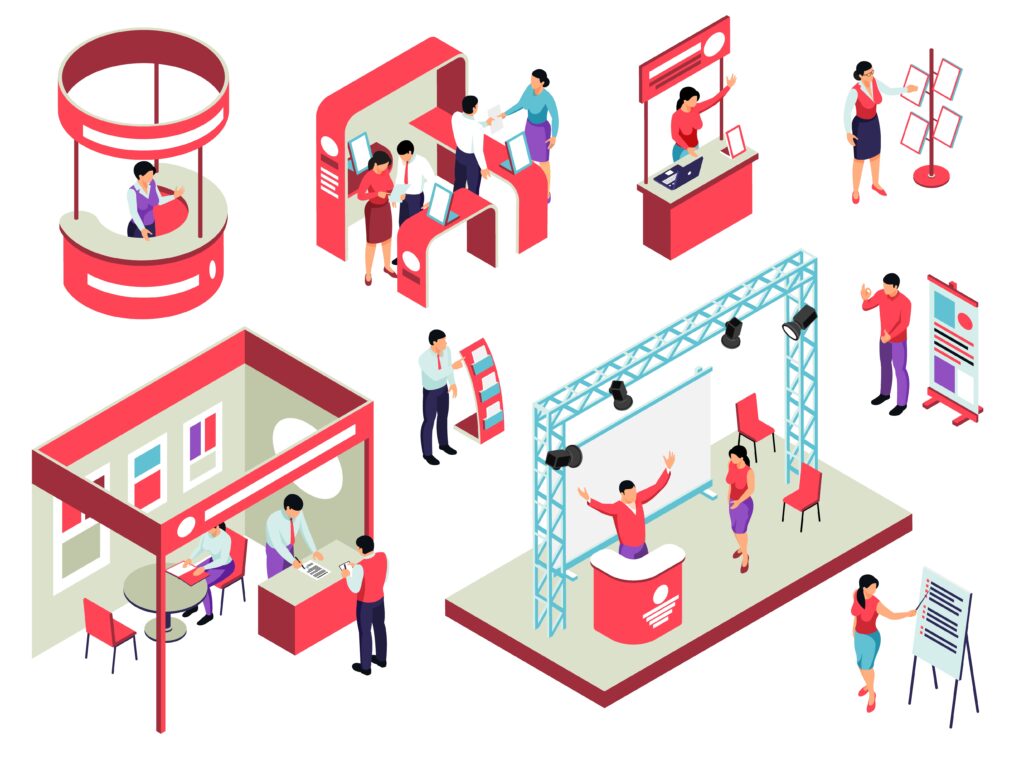
Career fairs, in all their forms, remain a cornerstone of campus recruiting. With the support of recruiting software solutions to tackle administrative hurdles, recruiting teams can see a significant rise in campaign effectiveness.
Smarter In-Person Fairs
The classic challenges of in-person fairs – paper trails, lost candidate data, and manual entry – can be a significant drain on productivity. Modern solutions aim to tackle this. For instance, dedicated career fair apps and lead capture tools (like Rakuna, among others) are designed to help recruiters:
- Digitally capture resumes and candidate information on the spot (often via QR codes or mobile apps).
- Quickly add notes, evaluations, or follow-up actions.
- Sync data directly to an ATS or CRM, streamlining post-event communication. The aim is to allow recruiters to engage more deeply with candidates, knowing the data capture is handled efficiently, and to create a centralized hub for managing the early-career talent pipeline.
Embracing Digital Interview & Assessment Platforms
Technology can make the interview and assessment process more efficient, scalable, and insightful.
-
Video Interviewing Tools: Platforms like HireVue, Spark Hire, VidCruiter, and others offer:
- ✅ Asynchronous (One-Way) Interviews: Candidates record answers to preset questions on their own time. This allows recruiters to screen more candidates efficiently.
- ✅ Synchronous (Live) Interviews: Facilitate live video conversations, often with scheduling and recording capabilities. Many now incorporate AI for features like interview scheduling, transcription, and even initial analysis (though ethical guidelines and potential biases in AI-driven assessment must be carefully considered and managed).
-
Skills Assessment Platforms: Beyond interviews, tools that allow candidates to demonstrate tangible skills are becoming increasingly popular. These can range from coding challenges (e.g., HackerRank, Codility) to situational judgment tests or gamified assessments, providing more objective measures of capability.
The Rise of AI in Campus Recruiting Tech
Artificial Intelligence (AI) is now an active component in many modern recruiting tools. It can help with:
- Candidate Sourcing & Matching: Identifying potential candidates from various pools based on skills and experience.
- Automated Communication: Chatbots for initial candidate screening or answering FAQs.
- Process Automation: Scheduling interviews, sending reminders.
- Data Analytics: Providing insights into recruitment funnels and effectiveness.
Ethical AI Use: You won’t have to scroll far on a product page to start reading about the various AI applications a recruiting solution can bring to the team. While AI offers powerful benefits, it’s crucial to ensure its use is ethical, transparent, and minimizes bias. Regularly audit AI-driven tools and processes for fairness and compliance with relevant regulations.
4. CAMPUS RECRUITING STRATEGY: PARTNERSHIP WITH COLLEGE CAREER SERVICES

Below, we highlight the best pieces of advice suggested by Career Services Professionals for working more efficiently and harmoniously with university career services and getting the right candidates for the job!
Empower Student Preparedness: Support Career Services Initiatives
Your first step in this partnership is to actively support the invaluable work career services already do. They are on the front lines, helping students translate academic achievements into career readiness. You can become an indispensable resource by:
- Sharing Your Real-World Wisdom: Think beyond simply presenting your company. Offer to roll up your sleeves for resume review or conduct insightful mock interview sessions, either on campus or virtually. Students crave this practical guidance.
- Tackling Tough Topics Together: Why not suggest a joint workshop on often-tricky subjects like “Decoding Job Offers & Negotiating Salary” or “Thriving in Your First Professional Year”? When you address the questions already on students’ minds, you build trust and position your brand as genuinely invested in their growth, creating a positive echo across the university.
BRING ALUMNI OR PEERS AS THE COMPANY’S AMBASSADORS
When it comes to connecting with students, authenticity is magnetic. Whose stories will they lean in to hear?
- Alumni as Bridges: Invite graduates from their own university, now part of your team, to share their journeys. There’s a unique power when a student hears from someone who literally walked the same campus paths and successfully navigated the transition to your company.
- The Relatability of Recent Grads: Whether they’re officially on your recruitment team or just passionate employees, recent graduates offer an unfiltered, fresh perspective. They can talk candidly about your culture, the learning curve, and the excitement of their early career in a way that truly connects.
OFFER OFFICE TOURS TO STUDENT GROUPS
Today’s students, especially high-achievers, are looking for more than just a job; they’re assessing long-term potential, a vibrant company culture, and a place where they can achieve work-life harmony. This is a consistent theme in findings from NACE student surveys and major analyses of Gen Z workplace desires.
- Beyond the Glossy Brochure: An office tour, whether a physical walk-through or an engaging virtual experience, can speak volumes.
- An Honest Look at Life at Your Company: This is your chance to showcase the energy of your workspace, the collaborative spirit of your teams, and the real projects they might tackle. Don’t shy away from discussing the challenges alongside the rewards; this transparency builds credibility and helps students see if your environment is truly where they can thrive.
SHOWCASE YOUR CULTURE AND DIVERSITY
Your company’s values, especially around culture and Diversity, Equity, and Inclusion (DEI), are not just buzzwords for students—they’re critical factors in their decision-making.
- Experiences Over Explanations: Move beyond website claims. When students see diverse teams actively engaged during your events, or hear firsthand from employees about your inclusive initiatives, it makes a profound impact.
- DEI as a Journey, Shared: Building a truly inclusive environment is an ongoing commitment. Your campus recruiting strategy can be a powerful catalyst. (If your original post offers a deeper dive, like the “10 tactics for a successful diversity campus recruiting program,” it’s a valuable resource to point to for those wanting to go further.) Partnering with career services can also open doors to connect with diverse student organizations, ensuring your message of inclusion is heard and felt.
💡 DEI in Practice with Career Services
Think about how you can collaborate with career services to truly live your DEI commitments:
- Ask for introductions to leaders of diverse student unions and clubs.
- When planning event panels, ensure a rich tapestry of voices and experiences from your team.
- Share stories about your Employee Resource Groups and the tangible impact they have.
- Double-check that all your materials and digital platforms are accessible to everyone.
- Invest in equipping your recruiting team with the awareness to recognize and mitigate unconscious bias.
HOST OR SPONSOR STUDENT EVENTS
Engage with university career services through various events, from presentations to job shadowing days. To get the most out of this campus recruiting strategy, listen to feedback and continuously update your presentations to avoid recycling the same content. Provide unique insights that students can’t easily find online, offering a deeper understanding of positions and company dynamics.
FOLLOW UP WITH STUDENTS
Foster positive relationships by being responsive and attentive to students throughout the recruiting process. Silence from employers, especially after initial responses or interviews, can be frustrating for students and challenging for career services. Focus on cultivating a strong on-campus employer brand by consistently engaging with students, offering them valuable workplace experiences, and utilizing eRecruiting tools for seamless communication.
Remember, a successful campus recruiting strategy involves building and maintaining connections. Your commitment to providing a great candidate experience and staying engaged with students over time will contribute significantly to your on-campus employer brand.
5. OTHER INNOVATIVE COLLEGE & UNIVERSITY RECRUITMENT STRATEGIES

| CLASSROOM SESSIONS OR LUNCHES | Do you recruit from one or more universities on a campus? Consider holding an informational session in the classroom with the dean or a professor there. While these are compelling ways to get undivided attention from your grads, you can also pack a one-two punch by doing one before or after a career fair. |
| ONLINE COMMUNITIES | Students are eager and willing to learn as much as possible about their new industry. Give them a leg up by creating an online community that publishes reports, industry trends, FAQs about jobs in the industry, and even an online learning curriculum that will prepare them for jobs in your organization. |
| HACKATHONS AND CONTESTS | Work with the career center to create a hackathon (these aren’t just for computer geeks anymore) in any industry or support one in your space that’s already planned! Either way, it’s a fun and less formal way to get to know students. |
| INTERVIEWS | Once again, the career center and your recruitment event software can be your best friends in creating time outside the traditional job fair times to simply conduct interviews. Have an interview day with those you met at a career fair, or work with professors and alumni associations to fill up a day with pre-selected applicants. The career center can also direct students your way. |
| TEAM HIRING | If the university you want to recruit from is near your home base, consider in-person events like being a judge on a panel, helping to assess and grade student portfolios, getting involved or supporting sporting and fine arts events and participating in semester-long projects as a “client.” |
| TECH-ENABLED INTERVIEWS | Don’t have the budget to travel everywhere for events? Try video interviewing and screening. This method is an efficient and easy way to see many prospects in a limited time. |
| BE A RESOURCE | If the university you want to recruit from is near your home base, consider in-person events like being a judge on a panel, helping to assess and grade student portfolios, getting involved or supporting sporting and fine arts events, and participating in semester-long projects as a “client.” |
Conclusion
Congratulations on delving into this comprehensive campus recruiting strategy & guide!
Armed with strategies ranging from meticulous event preparation to innovative hiring tips, you are well-equipped to navigate the dynamic landscape of attracting candidates from events and career fairs.
When you and your recruitment team are on the field, consider the transformative impact of technology solutions. Here’s where Rakuna’s Recruitment Software steps in as your ultimate ally
Ready to Experience the Future of Campus Recruitment?
Join us for a FREE DEMO to see how Rakuna’s Recruitment Software can streamline your campus hiring efforts. Experience how our solutions align perfectly with the strategies outlined in this guide to help you identify and secure the most suitable candidates for your organization.
To learn more, BOOK A DEMO HERE or contact [email protected].

Team Rakuna
The Rakuna Team comprises a diverse group of professionals hailing from various corners of the world.
With a passion to enable organizations to hire their next waves of talents, we are dedicated to help organizations stay updated on important recruiting technology and industry best practices.

